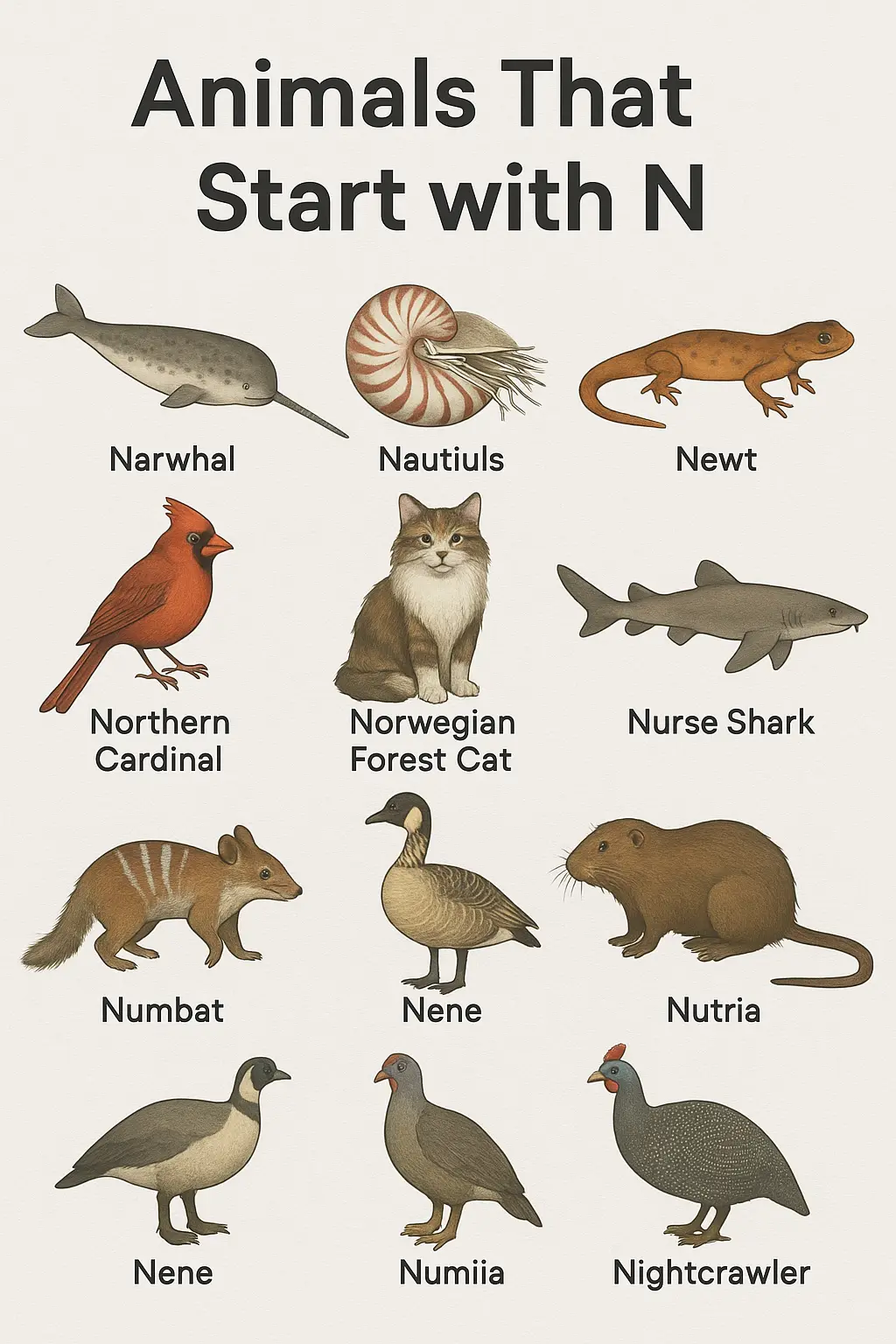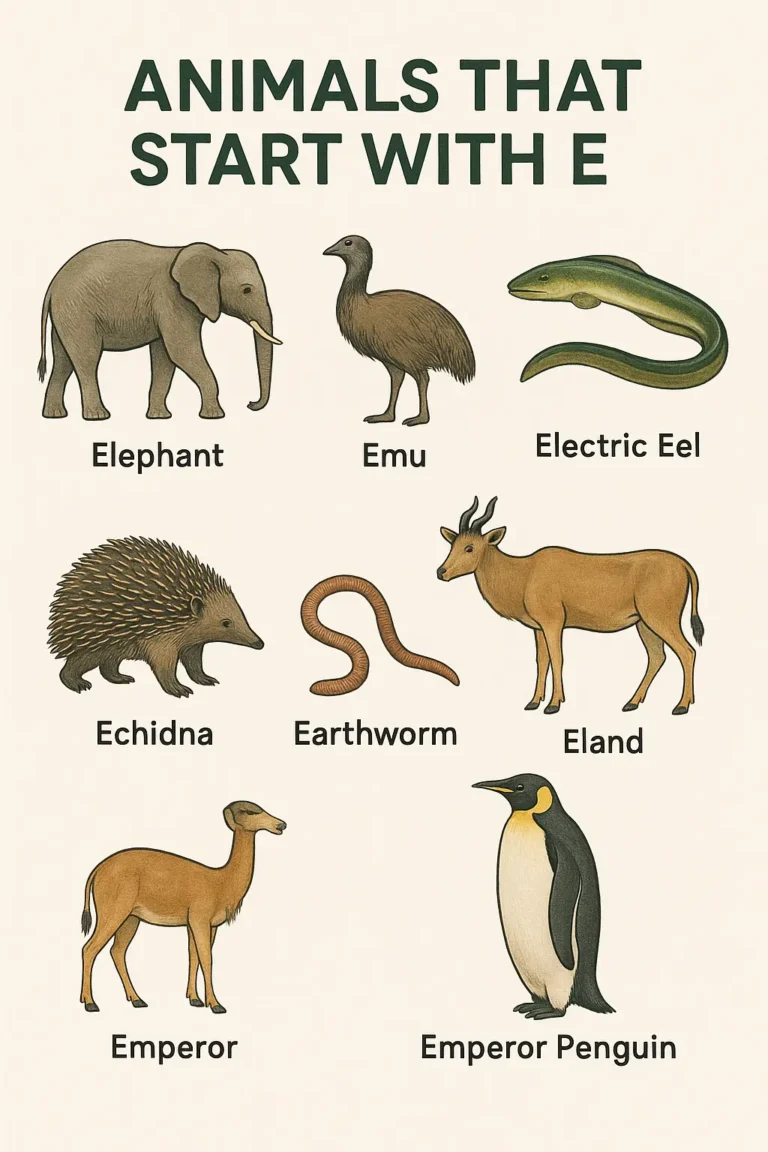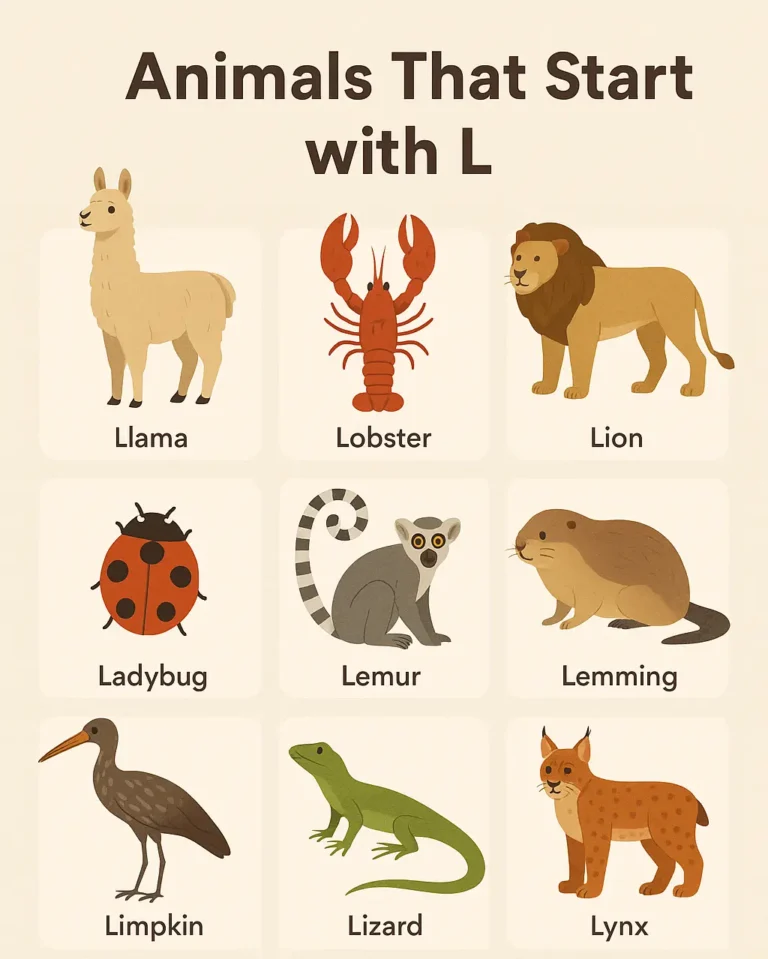Animals That Start With N | List & Examples

Many people search for animals by their first letter for school projects, games, or simple curiosity. Learning about animals that start with the letter N can help you discover both common pets and amazing wild creatures from around the world. This article covers domestic and wild animals that start with N, giving you facts about each one.
Here’s the simple list of animals that start with N :
- Narwhal
- Norwegian Forest Cat
- Numbat
- Nightjar
- Newt
- Nautilus
- Nightingale
- Nile Crocodile
- Nurse Shark
- Nutria
- Nilgai
- Nyala
- Nudibranch
- Nuthatch
- Nighthawk
- Nene
- Numbfish
- Neapolitan Mastiff
- Norfolk Terrier
- Newfoundland Dog
- Nubian Goat
- Nigerian Dwarf Goat
- Nankeen Kestrel
- Northern Cardinal
- Northern Pike
- Northern Mockingbird
- Northern Bobwhite
- Neon Tetra
- Nurse Log Beetle
- Natal Ghost Frog
- Natterjack Toad
- Nabarlek
- Naked Mole Rat
- Nanday Parakeet
- Narrow-mouthed Toad
- Needle-nosed Gar
- Nematode
- Nephila Spider
- Netted Sea Dragon
- New Guinea Singing Dog
- New Zealand Sea Lion
- Nicaraguan Grackle
- Nine-banded Armadillo
- Noctule Bat
- Noddy
- Norfolk Island Pine Snake
- North American Porcupine
- Northern Fur Seal
- Northern Gannet
- Northern Goshawk
- Northern Harrier
- Northern Leopard Frog
- Northern Right Whale
- Northern Saw-whet Owl
- Northern Screamer
- Northern Shoveler
- Northern Water Snake
- Norway Rat
- Nose-horned Viper
Check out the animals that start with the letter O
Domestic Animal Names That Start With N
Here’s a list of domestic animals that start with N :
- Norwegian Forest Cat
- Neapolitan Mastiff
- Norfolk Terrier
- Newfoundland Dog
- Nubian Goat
- Nigerian Dwarf Goat
- New Hampshire Red Chicken
- Nanday Parakeet
- Neon Tetra
- Norway Rat
- New Guinea Singing Dog
- Nankeen Kestrel
- Norfolk Horn Sheep
- Nubian Ibex
- Netherland Dwarf Rabbit
1. Norwegian Forest Cat
The Norwegian Forest Cat is a large, fluffy cat breed that comes from Norway. These cats have thick, water-resistant fur that helped them survive in cold forests. They are strong climbers and can even climb down trees head-first.
Norwegian Forest Cats make great pets because they are friendly and calm. They get along well with children and other pets. These cats are also called “Wegies” for short.
The breed almost disappeared during World War II, but cat lovers worked hard to save it. Today, Norwegian Forest Cats are popular pets around the world.
2. Neapolitan Mastiff
The Neapolitan Mastiff is a giant dog breed from Italy. These dogs can weigh up to 150 pounds and have wrinkled faces with droopy skin. They were originally used to guard homes and property.
Neapolitan Mastiffs are gentle giants that love their families. They are protective but not aggressive unless they need to defend their home. These dogs drool a lot because of their loose lips.
These mastiffs need early training and socialization because of their size. They are calm indoors but need daily walks to stay healthy.
3. Norfolk Terrier
The Norfolk Terrier is a small, sturdy dog breed from England. These dogs have wiry coats and small, folded ears. They were bred to hunt rats and other small animals on farms.
Norfolk Terriers are friendly, brave, and full of energy. They make good family pets because they are gentle with children. These dogs love to dig and explore, so they need a secure yard.
The breed is very similar to the Norwich Terrier, but Norfolk Terriers have dropped ears while Norwich Terriers have pointed ears. Both breeds are great companions for active families.
4. Newfoundland Dog
The Newfoundland Dog is a large, strong breed from Canada. These dogs have thick, water-resistant coats and webbed feet that make them excellent swimmers. They were originally used by fishermen to help with their work.
Newfoundland Dogs are known for being gentle and patient, especially with children. They are often called “nanny dogs” because they watch over kids so well. These dogs are natural lifeguards and have saved many people from drowning.
The breed comes in black, brown, gray, and black and white colors. Newfoundland Dogs need regular grooming because they shed a lot, especially during certain seasons.
5. Nubian Goat
The Nubian Goat is a dairy goat breed known for its long, floppy ears and curved nose. These goats originally came from Africa and the Middle East. They are excellent milk producers and give rich, creamy milk.
Nubian Goats are friendly and social animals that enjoy being around people. They are also quite vocal and will “talk” to their owners with different sounds. These goats come in many colors and patterns.
The breed adapts well to hot climates because of their desert origins. Nubian Goats need good fencing because they are excellent jumpers and climbers.
6. Nigerian Dwarf Goat
The Nigerian Dwarf Goat is a small dairy goat breed that comes from West Africa. These goats are much smaller than regular dairy goats but still produce high-quality milk. Adult females usually weigh about 75 pounds.
Nigerian Dwarf Goats are playful and friendly, making them popular as pets. They come in many colors and patterns, and their eyes can be blue or brown. These goats are excellent mothers and often have twins or triplets.
The breed is hardy and can live in many different climates. Nigerian Dwarf Goats need companionship and should not be kept alone because they are social animals.
7. New Hampshire Red Chicken
The New Hampshire Red Chicken is a dual-purpose breed that provides both eggs and meat. These chickens were developed in New Hampshire in the early 1900s. They have beautiful red feathers and are known for being hardy birds.
New Hampshire Red Chickens are calm and easy to handle, making them good for beginners. The hens lay brown eggs and are good mothers. These chickens are also good foragers and enjoy finding their own food.
The breed is cold-hardy and can handle harsh winters well. New Hampshire Red Chickens are active birds that need space to roam and explore.
8. Nanday Parakeet
The Nanday Parakeet is a colorful bird originally from South America. These parrots have bright green bodies with blue wings and a distinctive black head. They are intelligent birds that can learn to mimic human speech.
Nanday Parakeets are social birds that need lots of attention from their owners. They are active and playful, requiring toys and activities to keep them busy. These birds can live for 20-30 years with proper care.
The breed is also known as the Black-hooded Parakeet. Nanday Parakeets are loud birds that make various calls and sounds throughout the day.
9. Neon Tetra
The Neon Tetra is a small, colorful freshwater fish popular in home aquariums. These fish have bright blue and red stripes that make them easy to spot. They originally come from the Amazon River in South America.
Neon Tetras are peaceful fish that do best in groups of six or more. They are easy to care for and eat small flakes, pellets, or live foods. These fish prefer soft, slightly acidic water that mimics their natural habitat.
The fish are small, usually growing to only about 1.5 inches long. Neon Tetras are active swimmers that add beautiful color to any aquarium setup.
10. Norway Rat
The Norway Rat, also called the Brown Rat, is commonly kept as a pet. These rats are intelligent, social animals that can learn tricks and recognize their names. Pet rats are much cleaner and friendlier than wild rats.
Norway Rats are excellent pets for people who want an interactive small animal. They are curious and playful, enjoying toys and puzzles. These rats need companionship and should be kept in pairs or small groups.
Pet rats typically live 2-3 years and need a large cage with plenty of space to climb and explore. They are omnivores and eat a varied diet of pellets, fruits, and vegetables.
Wild Animal Names That Start With N
Here’s a list of wild animals that start with N :
- Narwhal
- Numbat
- Nightjar
- Newt
- Nautilus
- Nightingale
- Nile Crocodile
- Nurse Shark
- Nutria
- Nilgai
- Nyala
- Nudibranch
- Nuthatch
- Nighthawk
- Nene
- Numbfish
- Naked Mole Rat
- Natal Ghost Frog
- Natterjack Toad
- Nabarlek
11. Narwhal
The Narwhal is a unique whale that lives in Arctic waters. Male narwhals have a long, twisted tusk that can grow up to 10 feet long. This tusk is actually an enlarged tooth that spirals out of their upper jaw.
Narwhals are medium-sized whales that can grow up to 18 feet long. They live in the cold waters around Greenland, Canada, and Norway. These whales eat fish, squid, and shrimp.
The narwhal’s tusk was once thought to come from unicorns, making it very valuable in medieval times. Scientists now know the tusk helps males compete for mates and may help them sense changes in water pressure.
12. Numbat
The Numbat is a small marsupial that lives in Western Australia. These animals have striped fur and long snouts that help them find food. Numbats are one of the few marsupials that are active during the day.
Numbats eat only termites, using their long tongues to catch them. They can eat up to 20,000 termites in a single day. These animals have excellent hearing and can detect termites moving underground.
The Numbat is endangered, with fewer than 1,000 left in the wild. Conservation efforts are working to protect their habitat and increase their numbers through breeding programs.
13. Nightjar
The Nightjar is a nocturnal bird found on every continent except Antarctica. These birds have excellent camouflage that helps them hide during the day. They have wide mouths that help them catch insects while flying.
Nightjars are active at night when they hunt for moths, beetles, and other flying insects. They make distinctive calls that sound like churring or trilling. These birds nest on the ground and lay their eggs directly on leaves or soil.
The bird’s name comes from an old belief that they would steal milk from goats at night. In reality, nightjars were probably just hunting insects around farm animals.
14. Newt
The Newt is a type of salamander that can live both in water and on land. These amphibians have smooth, moist skin and can regenerate lost body parts. Newts go through several life stages, starting as aquatic larvae.
Many newt species are brightly colored, which warns predators that they are poisonous. They eat insects, worms, and small aquatic animals. Newts breathe through their skin and lungs.
Some newts can live for over 20 years in the wild. They hibernate during winter and become active again in spring when they return to water to breed.
15. Nautilus
The Nautilus is a marine animal related to squids and octopuses. These creatures have beautiful spiral shells divided into chambers. They use jet propulsion to move through the water by shooting water out of their bodies.
Nautiluses have been around for over 500 million years, making them living fossils. They live in deep ocean waters around coral reefs in the Pacific Ocean. These animals have simple eyes and tentacles without suction cups.
The nautilus shell has inspired art and architecture for centuries. Each chamber in the shell follows a mathematical pattern called the golden ratio.
16. Nightingale
The Nightingale is a small brown bird famous for its beautiful singing voice. These birds are found in Europe, Asia, and Africa. Male nightingales sing complex songs, especially during breeding season and at night.
Nightingales are shy birds that prefer to stay hidden in dense bushes and trees. They eat insects, worms, and berries. These birds migrate long distances between their breeding and wintering grounds.
The nightingale’s song has inspired many poets and musicians throughout history. These birds can learn new songs and have a repertoire of over 200 different phrases.
17. Nile Crocodile
The Nile Crocodile is one of the largest reptiles in the world. These powerful predators can grow up to 20 feet long and weigh over 1,500 pounds. They live in rivers, lakes, and marshes throughout Africa.
Nile Crocodiles are excellent hunters that can remain perfectly still for hours waiting for prey. They eat fish, birds, mammals, and other reptiles. These crocodiles are also caring parents that protect their young.
The ancient Egyptians worshipped crocodiles and even mummified them. Today, Nile Crocodiles are protected in many areas, but they still face threats from habitat loss and hunting.
18. Nurse Shark
The Nurse Shark is a slow-moving shark found in warm coastal waters. These sharks are usually harmless to humans and spend most of their time resting on the ocean floor. They have small mouths and feed on small fish and invertebrates.
Nurse Sharks can grow up to 14 feet long and have a distinctive rounded tail. They are nocturnal hunters that use their excellent sense of smell to find food. These sharks can survive in shallow water where other sharks cannot.
The name “nurse shark” might come from the sucking sound they make when eating, which sounds like a nursing baby. These sharks are popular in aquariums because they are docile and easy to care for.
19. Nutria
The Nutria is a large rodent that looks like a cross between a beaver and a rat. These semi-aquatic animals originally come from South America but now live in many parts of the world. They have webbed feet and can swim very well.
Nutrias were brought to other countries for their fur, but many escaped and became invasive species. They eat plants and can damage wetland ecosystems by destroying native vegetation. These animals can reproduce quickly and are difficult to control.
A single nutria can eat up to 25% of its body weight in plants each day. They build burrows in riverbanks and can cause erosion problems in some areas.
20. Nilgai
The Nilgai is the largest antelope in Asia and lives in India and Pakistan. These animals have blue-gray coats and long legs built for running. Male nilgais have short, straight horns and are larger than females.
Nilgais prefer open grasslands and light forests where they can graze on grass and leaves. They are excellent jumpers and can leap over fences up to 6 feet high. These antelopes are active during the day and rest in shade during hot weather.
The name “nilgai” means “blue cow” in Hindi, referring to their blue-gray color. These animals are considered sacred by some people in India and are protected in certain areas.
Conclusion
This guide covered many different animals that start with the letter N, from domestic pets like Norwegian Forest Cats and Newfoundland Dogs to wild creatures like Narwhals and Nile Crocodiles. You discovered both common household animals and exotic species from around the world. Each animal that starts with N has unique characteristics that make it special in its own way.
Whether you’re looking for information about domestic animals that start with N for a pet choice or learning about wild animals that start with N for educational purposes, this list provides a good starting point. Consider exploring animals that begin with other letters to expand your knowledge of the animal kingdom.






